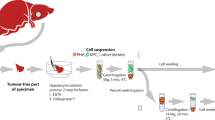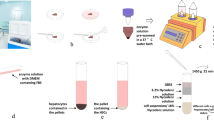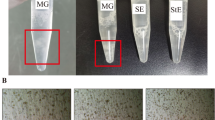Abstract
LIVER cells have been isolated by various methods, such as by forcing the tissue through stainless steel sieves1, by tryptic digestion2 and by incubation in acid solutions3. Anderson4 obtained a high yield of cells by perfusion of liver with calcium-free solutions containing chelating agents (such as ethylenediamine tetraacetate (versene) or citrate) and subsequent dispersion.
This is a preview of subscription content, access via your institution
Access options
Subscribe to this journal
Receive 51 print issues and online access
$199.00 per year
only $3.90 per issue
Buy this article
- Purchase on Springer Link
- Instant access to full article PDF
Prices may be subject to local taxes which are calculated during checkout
Similar content being viewed by others
References
Kaltenbach, J. P., Exp. Cell Res., 7, 568 (1954).
Dulbecco, R., and Vogt, M., J. Exp. Med., 99, 167 (1954).
Longmuir, I. S., and ap Rees, W., Nature, 177, 997 (1956).
Anderson, N. G., Science, 117, 627 (1953).
Branster, M. V., and Morton, R. K., Aust. J. Sci., 19, 72 (1956).
Kamphausen, H., and Morton, R. K., Biochem. J., 63, 647 (1956).
Novikoff, A. B., J. Biochem. Biophys. Cyt., 2, 65 (1956).
Author information
Authors and Affiliations
Rights and permissions
About this article
Cite this article
BRANSTER, M., MORTON, R. Isolation of Intact Liver Cells. Nature 180, 1283–1284 (1957). https://doi.org/10.1038/1801283a0
Issue Date:
DOI: https://doi.org/10.1038/1801283a0
This article is cited by
-
Allogeneic liver cell suspension in the treatment of hepatic failure
Bulletin of Experimental Biology and Medicine (1978)
-
Studies on hormonal regulation of metabolism using isolated hepatocytes
Acta Diabetologica Latina (1976)
-
Existence of hepatic cell classes and their relationship with the nuclear classes in the liver of the white mouse
Histochemie (1970)
-
The preparation of metabolically active suspensions of mouse liver cells
Experientia (1967)
-
The fine structure of rat liver cells in suspension
Zeitschrift f�r Zellforschung und Mikroskopische Anatomie (1967)
Comments
By submitting a comment you agree to abide by our Terms and Community Guidelines. If you find something abusive or that does not comply with our terms or guidelines please flag it as inappropriate.



